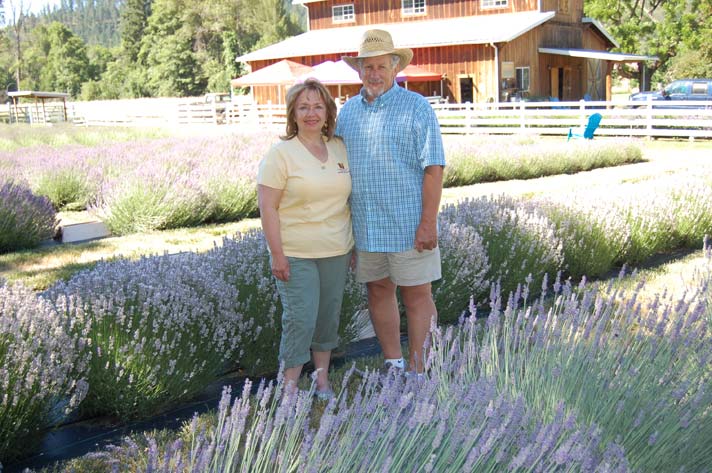The Literary Gardener – July 2015
“I judge that the flowers of Lavender quilted in a cap and worn are good for all diseases of the head…and that they comfort the brain very well.” ~ William Turner, New Herball, 1551
Many of the students I teach at Rogue Community College tell me they hope to use their education to move away from Southern Oregon. Much of their youthful disdain for their hometowns stems from limited experiences elsewhere, so I understand their “greener pastures” mindset. In fact, I’ve moved around quite a bit myself. However, after living in seven different states and a dozen cities and towns, I’m happy to now call Southern Oregon my home.
I was recently reminded of my gladness as I stood in the middle of John and Bonnie Rinaldi’s Lavender Fields Forever, nestled in the beautiful Applegate Valley just 15 minutes outside of downtown Jacksonville. I was surrounded by a silvery expanse of lavender hillocks, each sending-up a multitude of sturdy stalks tipped with purple buds ready to burst into flower. It didn’t take me long to become spellbound by the gentle sway of lavender wands waving magic across the rows. There was absolutely no place else I wanted to be—the lavender did, indeed, “comfort the brain very well.”
July and August is the time to experience the magic of lavender along the Southern Oregon Lavender Trail. The route features the Demonstration Lavender Garden at the Southern Oregon Research and Extension Center in Central Point and five commercial farms in the Applegate Valley: Lavender Fields Forever, The English Lavender Farm, Goodwin Creek Gardens, Luna Blue Farm, and Two Sisters Lavender Farm. Also nearby is Applegate Valley Lavender Farm. All venues are open during the summer on the weekends; for specific days and times, check Facebook/SouthernOregonLavenderTrail.
The lavender sites are all within a 30-mile radius, so visitors can thoroughly scintillate their senses by stopping at every location (perhaps pausing in between to quench their thirst at one of several wineries in the Applegate). Each farm has a variety of activities to choose from: pick lavender bouquets from a hundred different varieties, make lavender wreaths, learn how-to distill essential oils, or simply stroll among the fragrant rows. Each farm also offers a variety of lavender-based craft, cosmetic, and culinary products for sale: soaps, lotions, sprays, lavender-infused honey, jams, ice cream, chocolates, and much more.
In addition to reveling in the sensory experience of lavender, visitors also learn how this aromatic herb is grown and harvested. This year, each farm is providing information about different lavender pollinators. At Lavender Fields Forever, for example, the Rinaldis show guests the mason bee houses they’ve erected to attract these small but prolific pollinators to their field. John told me mason bees fertilize up to 20 times more flowers than honeybees. Female mason bees build nests in tiny cavities within tube-shaped holes in the houses. They collect pollen and nectar from the lavender flowers to incubate an egg laid in each cavity, and then they plug-up each compartment until the hole is completely filled, thus sealing the eggs from predators (hence the name ‘mason’ bee).
There’s so much to see, smell, taste, and learn about lavender! Trail blazers can collect stamps on their Lavender Passport, available at each farm; those who collect stamps at all five participating lavender farms by August 16 will be entered into a drawing to win a gift basket filled with lavender products. Bonnie said more than 400 lavender lovers vied for the prize last year, out of thousands of visitors during the lavender blooming season. In fact, the Southern Oregon Lavender Trail has become increasingly popular since the Rinaldis gathered the local lavender farms to form the trail in 2012.
The couple moved to Southern Oregon four years ago after retiring from city government careers in the Las Vegas area. Since starting their lavender farm, John said they’ve been working hard at their so-called “summer job,” but the rewards are more than worth all the effort. The best part? “Seeing all the happy people” who visit their farm, John and Bonnie agreed. “Lavender really does have a calming effect; people start to decompress when they come out here,” John said.
I can certainly attest to that! I didn’t want to leave this magical land of lavender, but I reassured myself I can return anytime I want during the next two months. Yes, I do feel lucky to live in Southern Oregon. And I’ll be sure to tell my summer RCC students about our Lavender Trail; it’s one more reason for them to love it here, too.
There are lots of reasons to love lavender! Originating in Mediterranean regions, ‘Lavandula’ thrives in Southern Oregon’s hot summers. Drought-tolerant, lavender requires lots of sun and performs best in sandier, alkaline soils (pH 7.5-8.0). Too much nitrogen tends to make the stems woodier, so be careful not to over-fertilize. Deer and most insects are repelled by lavender, and the plant is not prone to disease. A lavender bush can live up to 20 years under the right conditions. Plants benefit from a hard cut in the fall, down to about 2 inches of foliage.

 Rhonda Nowak is a teacher, writer and gardener who lives and works in the Rogue Valley. She has taught literature and language arts for 25 years, the last six at Rogue Community College. In addition to her column for the Jacksonville Review, she writes a weekly column and blog called the Literary Gardener for the Mail Tribune. She also writes articles for Southern Oregon Wine Scene magazine and is writer and editor of Ashland Living magazine. Email Rhonda at Rnowak39@gmail.com.
Read more on her blog at
Rhonda Nowak is a teacher, writer and gardener who lives and works in the Rogue Valley. She has taught literature and language arts for 25 years, the last six at Rogue Community College. In addition to her column for the Jacksonville Review, she writes a weekly column and blog called the Literary Gardener for the Mail Tribune. She also writes articles for Southern Oregon Wine Scene magazine and is writer and editor of Ashland Living magazine. Email Rhonda at Rnowak39@gmail.com.
Read more on her blog at